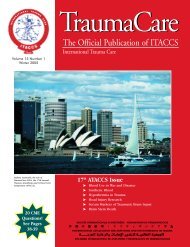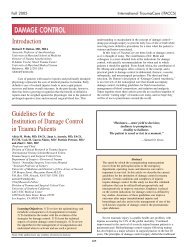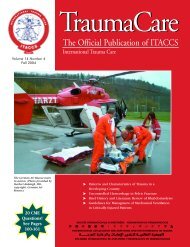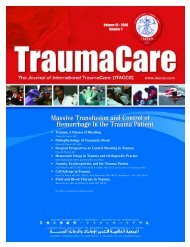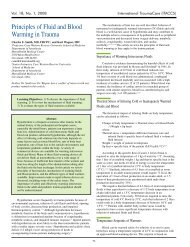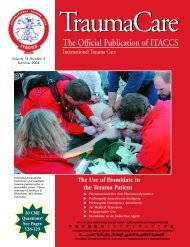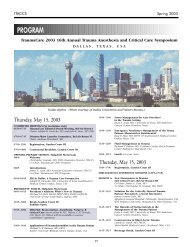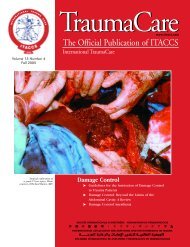The Official Publication of ITACCS - International Trauma ...
The Official Publication of ITACCS - International Trauma ...
The Official Publication of ITACCS - International Trauma ...
Create successful ePaper yourself
Turn your PDF publications into a flip-book with our unique Google optimized e-Paper software.
<strong>ITACCS</strong> Spring 2003<br />
all anesthetic management. Early establishment <strong>of</strong> adequate venous access and administration<br />
<strong>of</strong> warmed crystalloid and colloid fluids and blood products are essential to initial resuscitation.<br />
Fluid management is based on careful assessment and monitoring <strong>of</strong> physiological and<br />
laboratory values. <strong>The</strong> principles <strong>of</strong> successful management <strong>of</strong> the trauma patient are based on<br />
organization and preparation, assessment <strong>of</strong> the patient’s injuries, proper priority for therapeutic<br />
interventions, achievement and maintenance <strong>of</strong> a patent airway, fluid resuscitation,<br />
application <strong>of</strong> appropriate continuous invasive and noninvasive monitoring, correction <strong>of</strong> acidbase<br />
and electrolyte disturbances, and careful titration <strong>of</strong> anesthetic and adjunctive agents.<br />
<strong>The</strong> degree <strong>of</strong> functional outcome <strong>of</strong> trauma patients is largely dependent on the early involvement<br />
<strong>of</strong> sound principles <strong>of</strong> anesthesia care in the resuscitation and overall anesthetic management<br />
during the perioperative period. In a well-managed team approach, assessment and<br />
treatment are carried out in rapid succession or even simultaneously.<br />
Suggested Readings<br />
Barton CR. <strong>Trauma</strong> anesthesia. In Nagelhout J, Zaglaniczny K, eds. Nurse Anesthesia,<br />
2nd edition. Philadelphia, WB Saunders, 2001, pp 824–47.<br />
Barton CR, Beeson M, Campbell J. Anesthesia for the trauma patient. Curr Rev Nurse<br />
Anesth 1998; 20:241–52.<br />
Barton CR. Anesthesia for the trauma patient. In McIntosh LW, ed. Essentials <strong>of</strong> Nurse<br />
Anesthesia. New York, McGraw-Hill, 1997, pp 477–97.<br />
Grande CM. Mechanisms and patterns <strong>of</strong> injury: the key to anticipation in trauma management.<br />
Crit Care Clin 1990; 6:25–35.<br />
to percussion <strong>of</strong> one hemithorax, distended neck veins, or tracheal shift. An upright expirational<br />
chest radiograph provides definite information if the problem is significant. However,<br />
if the trauma patient is unstable, a large-bore intravenous catheter is inserted into the superior<br />
portion <strong>of</strong> the second intercostal space along the midclavicular line.<br />
Many thoracic injuries can be life threatening. Massive hemothorax, which can be<br />
caused by bleeding from the heart and great vessels, must be treated immediately. Adequate<br />
fluid resuscitation is accomplished before placement <strong>of</strong> chest tubes. Chest tubes allow<br />
drainage <strong>of</strong> blood from the pleural cavity but can lead to more extensive bleeding and<br />
hypotension. Pericardial tamponade that restricts filling <strong>of</strong> the cardiac chambers during diastole<br />
and produces a fixed low cardiac output is also a life-threatening emergency that requires<br />
immediate correction with pericardiocentesis. Patients with cardiac rupture without pericardial<br />
tamponade seldom survive because exsanguination is extremely rapid in this situation.<br />
<strong>Trauma</strong>tic aortic rupture, if complete, is usually fatal, but with an intimal tear with a dissecting<br />
aneurysm, the patient can be saved if the diagnosis and repair are performed promptly<br />
during well-managed fluid resuscitation and anesthesia care. Management <strong>of</strong> these cases<br />
requires rapid and accurate assessment and appropriate surgical and anesthesia intervention.<br />
Partial disruption <strong>of</strong> the trachea or major bronchi can be handled in many cases through<br />
securing <strong>of</strong> the airway (by intubation or tracheostomy) and surgical correction. Total disruption<br />
<strong>of</strong> the trachea is commonly fatal unless rapid surgical retrieval <strong>of</strong> the distal disrupted airway<br />
segment is accomplished; this measure allows life-saving mechanical ventilation.<br />
Diagnosis <strong>of</strong> stable chest injuries is frequently enhanced by computed tomography<br />
(CT), angiography, and other radiologic studies.<br />
Applying ATLS Guidelines to <strong>Trauma</strong> Care<br />
Wendell Spencer, CRNA, MHS<br />
President <strong>of</strong> North Central Anesthesia Services, LLC<br />
O’Neill, Nebraska, USA<br />
Learning Objective: To apply ATLS guidelines to management <strong>of</strong> the trauma<br />
patient in the critical care setting by CRNAs.<br />
Assessment <strong>of</strong> the patient should begin with the airway. 1 Decisions should be made in<br />
the opening minutes <strong>of</strong> assessment to recognize pitfalls in establishing the airway, recognition<br />
<strong>of</strong> the incorrectly established airway, displacement <strong>of</strong> an ongoing airway, and the possibility<br />
<strong>of</strong> aspiration.<br />
Problems that can occur early in assessment include several types <strong>of</strong> trauma: head<br />
trauma, neck trauma, and maxill<strong>of</strong>acial trauma that may influence the type <strong>of</strong> airway control<br />
used. <strong>The</strong> goal should be to provide airway support and deliver oxygen without causing further<br />
harm to patients (i.e., aspiration, further trauma).<br />
Maxill<strong>of</strong>acial trauma patients should be assessed for their ability to breath in supine<br />
position and for fractures to the trachea or oropharynx. Neck trauma patients may have penetrating<br />
injuries that cause displacement <strong>of</strong> the trachea and require tracheostomies.<br />
Associated laryngeal trauma may include a triad in the fracture <strong>of</strong> the larynx, including hoarseness,<br />
subcutaneous emphysema, and a palpable fracture.<br />
In the initial assessment <strong>of</strong> the airway, look, listen, and feel for any abnormalities.<br />
Looking at the airway should include observation <strong>of</strong> obstruction, decreased air movement,<br />
retraction, deformity, and debris. Listening to the airway may reveal noisy speech, gurgle or<br />
stridor, or hoarseness requiring further intervention. Feeling the airway may reveal the location<br />
<strong>of</strong> the trachea, hematoma formation, or fracture locations.<br />
Ventilation capabilities must be assessed for factors <strong>of</strong> the central nervous system that<br />
may impede the airway. <strong>The</strong>se factors may include CNS depression, blunt chest trauma, spinal<br />
cord injury, and other problems.<br />
Management <strong>of</strong> patients must always include immobilization <strong>of</strong> the neck at all times<br />
with traction on the head in a neutral position and care to avoid complicated fractures <strong>of</strong> the<br />
face and nasal area. Needs for definitive airways include the following types <strong>of</strong> patients:<br />
unconscious, severe maxill<strong>of</strong>acial trauma, and those at risk for obstruction or aspiration.<br />
Nasal tracheal intubation should be used only when clearly indicated. Airway algorithms<br />
should be followed to minimize poor decision making in choosing the next step in assisting<br />
the patient to ventilate. Jet ventilators or surgical cricothyrotomies may be used as a last<br />
resort in rescuing the airway. 2,3<br />
References<br />
1. Wheeler M, Ovassapian A. Prediction and evaluation <strong>of</strong> the difficult airway. In<br />
Hagberg CA, ed. Handbook <strong>of</strong> Difficult Airway Management. Philadelphia:<br />
Churchill Livingstone, 2000, pp 15–30.<br />
2. Bowman-Howard M. Management <strong>of</strong> the traumatized airway. In Hagberg CA, ed.<br />
Handbook <strong>of</strong> Difficult Airway Management. Philadelphia: Churchill Livingstone,<br />
2000, pp 319–45.<br />
3. Melker RJ, Florete OG. Cricothyrotomy: review and debate. In Doyle DJ, Sandler<br />
AN, eds. <strong>The</strong> Difficult Airway II. Anesthesiol Clin North Am 1995; 13: 565–83.<br />
Anesthetic Management <strong>of</strong> the Patient Sustaining Thoracic <strong>Trauma</strong><br />
Charles R. Barton, CRNA, MSN, M.Ed.<br />
Director, Graduate Anesthesia Program, <strong>The</strong> University <strong>of</strong> Akron<br />
College <strong>of</strong> Nursing, Akron, Ohio, USA<br />
Learning Objectives: To understand manifestations and management <strong>of</strong> the lifethreatening<br />
conditions that can result from blunt thoracic trauma.<br />
Blunt thoracic trauma <strong>of</strong>ten results from the impact <strong>of</strong> drivers who are not wearing<br />
safety belts into the steering wheel during a motor vehicle crash. Penetrating and blunt trauma<br />
to the chest may injure several structures and thus compromise optimal resuscitation.<br />
<strong>The</strong>se structures include the chest wall, the lungs and airways, the heart and pericardium,<br />
and the great vessels <strong>of</strong> the thorax. Injuries to these structures also compromise anesthesia<br />
care by affecting gas exchange and cardiac output.<br />
Several life-threatening conditions require immediate interventions in patients with<br />
chest injuries. A tension pneumothorax develops when the pleural cavity is punctured, creating<br />
a one-way valve that controls the flow <strong>of</strong> air into this cavity. With each breath, more air<br />
becomes trapped in this space, increasing intrapleural pressure to the point that it eventually<br />
exceeds all other intrathoracic pressures. <strong>The</strong> enlarging pleural cavity then collapses the<br />
ipsilateral lung and shifts structures <strong>of</strong> the mediastinum (e.g., trachea, great vessels, heart)<br />
into the opposite hemithorax, thereby compressing the contralateral lung. <strong>The</strong> size <strong>of</strong> a<br />
pneumothorax rapidly increases during positive-pressure ventilation, especially if nitrous<br />
oxide is used in the field for analgesia or during anesthesia in the trauma facility. Patients with<br />
a pneumothorax <strong>of</strong>ten present with hypotension, subcutaneous emphysema <strong>of</strong> the neck or<br />
chest, unilateral decrease in breath sounds, diminished chest wall motion, hyper-resonance<br />
Anesthetic Management <strong>of</strong> the <strong>Trauma</strong> Patient in the Rural Health Care Setting<br />
Wendell Spencer, CRNA, MHS<br />
President <strong>of</strong> North Central Anesthesia Services, LLC<br />
O’Neill, Nebraska, USA<br />
Learning Objective: To discuss the anesthetic considerations unique to the rural<br />
health care trauma patient as they relate to the area <strong>of</strong> shock.<br />
<strong>The</strong> rural health patient presents many challenges to the anesthetic care provider in<br />
resources and in the management and treatment <strong>of</strong> shock. Recognition <strong>of</strong> the signs and<br />
symptoms <strong>of</strong> shock is the key to successful intervention and treatment <strong>of</strong> trauma patients.<br />
Shock is defined as both inadequate tissue/organ perfusion and a lack <strong>of</strong> tissue oxygenation.<br />
Knowledge <strong>of</strong> cardiac output and stroke volume is necessary to evaluate the patient<br />
who presents in shock. Cardiac output is the volume <strong>of</strong> blood pumped per minute as a result<br />
<strong>of</strong> heart rate and stroke volume. Stroke volume is the amount <strong>of</strong> blood pumped by the heart<br />
as determined by preload, myocardial contractility, and afterload. 1<br />
Early changes <strong>of</strong> blood loss include tachycardia, progressive vasoconstriction, release<br />
<strong>of</strong> histamine, and bradykinin. Initial goals include restoring cardiac output via volume repletion<br />
with isotonic solutions. 1 Vasopressors may be contraindicated at this time due to the<br />
need for volume replacement and the additional stress placed on the heart muscle.<br />
Recognition <strong>of</strong> shock includes tachycardia, vasoconstriction, decreased cardiac output,<br />
a narrowing pulse pressure, decreasing mean arterial pressures, and decreased blood flow.<br />
Tachycardia varies by patient age group, and normal values should be taken into consideration<br />
while assessing the patient. 1<br />
Pitfalls in assessment <strong>of</strong> the shock patient include extremes <strong>of</strong> age, athletes, pregnant<br />
patients, medications ingested by the patient prior to arrival, and misleading hemoglobin and<br />
hematocrit values resulting from fluid resuscitation.<br />
Types <strong>of</strong> shock include hemorrhagic, cardiogenic, neurogenic, and some types <strong>of</strong> septic<br />
shock. Class I, II, III, and IV types <strong>of</strong> hemorrhagic shock can start as “minor” emergencies<br />
and quickly turn into the loss <strong>of</strong> patient life. Initial assessment <strong>of</strong> the patient and rapid allocation<br />
<strong>of</strong> equipment and personnel may yield the difference in outcome to the patient in the<br />
rural health setting. 1<br />
Equipment such as a large-volume rapid infusion system, forced-air warmer, intravenous<br />
fluid warmer may be utilized to reverse hypothermia and <strong>of</strong>fset blood loss quickly. 2<br />
Lab personnel and nursing staff are essential to respond rapidly to the patient’s changing condition.<br />
ATLS( guidelines and practice trauma drills are helpful in training the trauma team to<br />
respond successfully to trauma patients and assist practitioners in the “rules <strong>of</strong> engagement”<br />
for highly successful outcomes.<br />
References<br />
1. Dutton RP. Shock and trauma anesthesia. In Grande CM, Smith CE, eds. <strong>Trauma</strong>.<br />
Anesthesiol Clin North Am 1999; 17:83–96.<br />
2. McCunn M, Karlin A. Nonblood fluid resuscitation. In Grande CM, Smith, eds.<br />
<strong>Trauma</strong>. Anesthesiol Clin North Am 1999; 17:107–24.<br />
Airway Management in <strong>Trauma</strong> Patients<br />
James M. Rich, MA, CRNA<br />
Baylor University Medical Center, Dallas, Texas, USA<br />
Learning Objective: Upon completion <strong>of</strong> this lecture, the participant will be able to<br />
list the four anatomic variants associated with a potential difficult airway.<br />
Airway management and fluid resuscitation are the two most important priorities <strong>of</strong><br />
the trauma patient, if there is to be any chance <strong>of</strong> viable survival without significant disability.<br />
This lecture will cover important aspects <strong>of</strong> airway management for the trauma patient.<br />
Airway anatomy, evaluation, and assessment <strong>of</strong> the airway with recognition <strong>of</strong> airway<br />
distortion caused by either blunt or penetrating trauma are crucial to develop an appropriate<br />
plan <strong>of</strong> care. Remembering the “four Ds” will aid in airway assessment, i.e., disproportion, distortion,<br />
decreased range <strong>of</strong> motion, and dental overbite. 1<br />
In order to provide rapid correction <strong>of</strong> the “Crash Airway” patient, a quick method for<br />
recognizing this situation is crucial. Application <strong>of</strong> Mason’s PU-92 concept accomplishes<br />
this. 2,3 Rational selection <strong>of</strong> an appropriate airway technique to include aspiration prophylaxis<br />
and protection <strong>of</strong> suspected or evident cervical spine injuries is paramount. Populations<br />
that require special consideration in trauma include obstetrical patients, pediatric patients,<br />
patients with a traumatized airway, and patients with suspected or evident cervical spine<br />
injuries. Methods to secure the airway in these populations will be discussed. 4<br />
When airway difficulty is suspected, the practitioner must decide to either to temporarily<br />
avoid tracheal intubation through use <strong>of</strong> a non-intubation airway technique with or<br />
without application <strong>of</strong> a minimally invasive airway option. It is also crucial in the face <strong>of</strong><br />
potential intubation difficulty that consideration be given to a technique that allows spontaneous<br />
ventilation versus apnea secondary to use <strong>of</strong> neuromuscular blocks.<br />
<strong>The</strong> choice <strong>of</strong> rapid-sequence intubation (RSI) should be reserved for patients with no<br />
61




